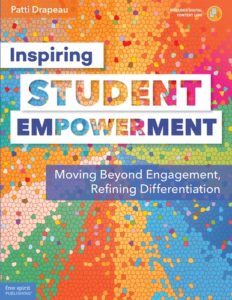Boost Empowerment, Refine Differentiation
Inspiring Student Empowerment: Moving Beyond Engagement, Refining Differentiation
By Patti Drapeau
(Free Spirit Publishing, 2020 – Learn more)
Reviewed by Sarah E. Pennington

Even more challenging – how can we move from creating a classroom full of engaged learners to one in which students feel empowered and take charge of their own learning?
Inspiring Student Empowerment: Moving Beyond Engagement, Refining Differentiation provides strategies and tools to support teachers in achieving this goal. The author balances research into student learning with application for the classroom in a reader-friendly way.
What engagement and engagement looks like in school

Chapter 3 provides information on teaching practices that support student empowerment, and Chapter 4 takes a closer look at game-based educational practices as a tool for empowering students in the classroom.
How differentiation can become personalized learning
Part 2 of the book focuses on differentiation and personalized learning. Chapter 5 defines differentiation and examines its key elements. Chapter 6 provides a definition and examples of personalized learning.
Chapter 7 provides tools for supporting students in designing their own instruction. Chapter 8 wraps up by connecting social and emotional learning (SEL) with both empowerment and personalized learning.
Everything you need, efficiently laid out
Each chapter includes clear headings to guide the reader who may want to revisit a specific topic or idea, as well as example activities and resources. Sidebars supply anecdotes about the strategies in action, additional resources, and featured ideas.
Discussion questions at the end of each chapter provide a moment for the reader to reflect on how the ideas in the chapter could be applied to their unique context. Finally, blank versions of organizers and other tools discussed in the chapter are included at the end of the chapter, making them easy to find while the information is still fresh in the reader’s mind.
What I – and students – can use
As I read through this book, a few things stuck out to me as ideas I want to remember and put in my own toolbox. One of my major takeaways was the difference between Big E and Little e engagement experiences.
Although the impact of the two is different (with Big E being large-scale and having an impact beyond the student, while Little e is more of a small, personal empowerment experience), Drapeau points out that both are equally important. I found myself reflecting on my previous middle grades classroom, considering the empowerment experiences I facilitated and whether each was a Big E or Little e.
Among the tools featured in the book, one of my favorites is a student tool called the “Decision-Making Analyzer.” This tool helps students consider various assignment product options to determine which would be the best choice for them. Factors to consider include the due date, availability of materials, interest in completing the product, and the degree to which it will allow them to show depth of relevant knowledge.
This is a tool I can see middle grades students utilizing effectively – especially with some scaffolding – and it could also serve as an excellent discussion starter for a one-on-one teacher/student goal setting discussion.
Useful ideas with the tools to bring them to life
Drapeau has done an excellent job writing a book that will push teachers to think about their classroom instruction and environment more deeply while also providing the tools to make this reflection possible.
The variety of examples and templates throughout the book provide concrete scaffolding for teachers who truly want to move their students from engagement to empowerment and to upgrade their instruction from differentiated to personalized learning.
Dr. Sarah E. Pennington taught middle school language arts for a decade before returning to school to pursue her doctoral degree in curriculum and instruction. She is currently an assistant professor at Montana State University, where she teaches pre-service educators the ins and outs of supporting young literacy learners. She also provides professional development in literacy and motivation to teachers across the nation.



































Excellent review. Thank you for taking the time to share.